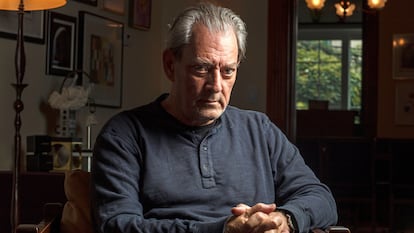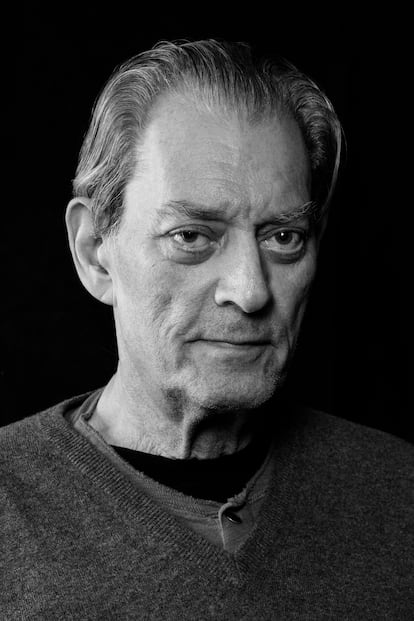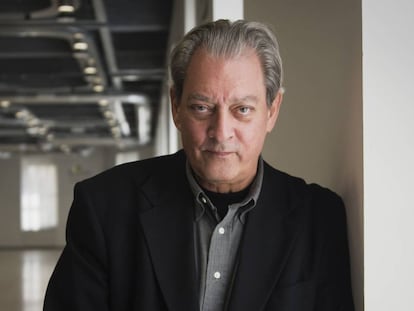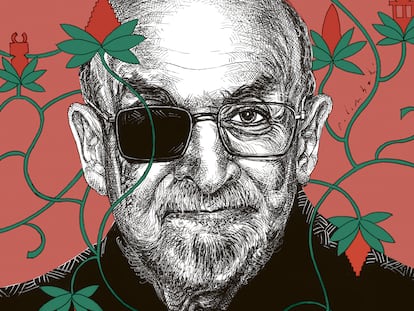In the midst of his battle against cancer, Paul Auster publishes a novel of enormous human and literary value
‘Baumgartner’ reads like a distilled mix of everything that the author of ‘New York Trilogy’ has ever written

It feels like an obituary, written by the protagonist of a life whose end looms near. Last March, the writer Siri Hustvedt, wife of Paul Auster, announced that the author had cancer. Among the 18 novels penned by the American writer (New Jersey, 1947), the last one, Baumgartner, recently published in the United States, surprises with its emotional depth and the simplicity of its narrative range. It is as if it contained a distilled mix of everything that the author ever included in his celebrated body of work. After playing with all the registers available to fiction, exploring its limits, Baumgartner condenses five decades of narrative wisdom. In only 200 pages, Paul Auster’s latest novel contains subtle echoes of many of his previous stories, mimicking the dance of death executed in Travels in the Scriptorium (2006), a book where Auster says goodbye to the ghosts of literary creation that had been his characters.
A little less than a year ago, cancer forced Auster to disappear from public life. Shortly before his diagnosis, he had been seen with other writers on the steps of the New York Public Library, showing his support for his friend Salman Rushdie, who had been the victim of a violent attack. After that came a long silence, occasionally interrupted by the announcements that Hustvedt posted on Instagram to report on the state of her husband, celebrating his strength and resilience as he underwent a devastating medical treatment. The images did not bode well, giving rise to speculation about his situation. A wall of concern, respect and sympathy surrounded his image. Until then, Auster had not stopped writing a single day in his life.
The monumental surprise — even for himself — was that after finishing Burning Boy: The Life and Work of Stephen Crane, his imagination compelled him to create what is destined to be one of his most endearing characters: the septuagenarian Baumgartner, emeritus professor of philosophy at Princeton University. Although he retains his autonomy as a character, in more ways than one Baumgartner is a reflection of his creator, a creature that arrived late to the celebrations of the scriptorium that is Auster’s imagination. In this book, the writer dispenses with the games of artifice characteristic of other moments in his career. A host of influences converges in the novel — most notably Hustvedt’s, whose ideas on phenomenology reverberate in the old professor’s thoughts. Surprisingly, there are also echoes of the great Philip Roth: the pages devoted to the life of New Jersey’s Jewish communities bring Roth’s Newark fictions to mind. And then there are also echoes of the historical recreations of E.L. Doctorow, another giant. Signs of a late style? No. This is about something deeper, more complex.
All the Austers come together In Baumgartner; even those that are not part of his fictional world, but arise from the author’s family history. The novel includes texts both from Baumgartner’s companion, who died 10 years before the beginning of the narration (again, we find hints of Hustvedt in her personality) and from the character himself, one of them previously published by Auster under his own name, The Wolves of Stanislav, the account of a trip made by the author to Ukraine in search of the origins of part of the Auster family, appropriated by Baumgartner in the novel. Thus, author and character merge in a surprising alchemical ritual of seamless workmanship. This is the sense in which the novel reads like an obituary, as if Auster were telling us that no one but himself has the right to compose his farewell to life. Auster could not stop writing. He did not know how. Seeing him helpless, Baumgartner immediately came to his aid.
After starting out as a poet in 1987, Auster published what is probably his most influential work: the New York Trilogy, a philosophical detective story that initiated a new way of writing novels. Then came a parade of titles that celebrate the power of fiction from a dizzying multitude of angles, dominated by the sign of chance. Among them: In the Country of Last Things, Moon Palace, The Music of Chance, Mr. Vertigo, The Book of Illusions, Oracle Night, Travels in the Scriptorium. And let’s not forget the caliber of his remarkable contributions in the field of non-fiction: The Invention of Solitude, The Red Notebook, Winter Journal, Report from the Interior. The list closes this year with Bloodbath Nation, an essay about the insane massacres that devastate the United States with chilling regularity as a consequence of the easy availability of guns.

A suggestive filmography
One cannot talk about Paul Auster without mentioning his suggestive filmography, which includes such memorable titles as Smoke, Blue in the Face and Lulu in the Bridge. Back to fiction, the cornerstone of his work, it is also essential to mention novels like Man in the Dark, Sunset Park and the spectacular 4 3 2 1, a thousand-page novel where he twisted the loop of the poetics of his own narration to tell the story of Archie Ferguson from four different points of view. After its publication, Auster announced that he was done writing novels, turning to the biography of Stephen Crane, a brilliant poet who died at the age of 28. Similar in length to 4 3 2 1, Burning Boy: The Life and Work of Stephen Crane reads like a novel.
The action of this new novel takes place between 2018 and 2020, before the diagnosis that has his friends and fans in suspense. Amidst the speculation, the real obituaries are ready, filed and waiting in newsrooms around the world. I did not dare to do it before, but reading this unique and moving novel, different from anything Auster has done so far, inspired me to write a brief note to Siri Hustvedt, asking her to congratulate her husband on the happy achievement of his novel. A few hours later, I received a response. Paul thanks the email, Siri writes. He is fine, recovering from the atrocious treatment he has been undergoing for months. Hustvedt’s words make it clear that the future is uncertain. Everything is in the hands of chance. In Auster’s case, it could not be otherwise. At the end of the novel, Baumgartner’s car crashes into a tree as he tries to avoid a deer that crossed his path in the middle of the night. The reader sees him get out of the car and walk away towards the lights of a nearby house.
Sign up for our weekly newsletter to get more English-language news coverage from EL PAÍS USA Edition
Tu suscripción se está usando en otro dispositivo
¿Quieres añadir otro usuario a tu suscripción?
Si continúas leyendo en este dispositivo, no se podrá leer en el otro.
FlechaTu suscripción se está usando en otro dispositivo y solo puedes acceder a EL PAÍS desde un dispositivo a la vez.
Si quieres compartir tu cuenta, cambia tu suscripción a la modalidad Premium, así podrás añadir otro usuario. Cada uno accederá con su propia cuenta de email, lo que os permitirá personalizar vuestra experiencia en EL PAÍS.
¿Tienes una suscripción de empresa? Accede aquí para contratar más cuentas.
En el caso de no saber quién está usando tu cuenta, te recomendamos cambiar tu contraseña aquí.
Si decides continuar compartiendo tu cuenta, este mensaje se mostrará en tu dispositivo y en el de la otra persona que está usando tu cuenta de forma indefinida, afectando a tu experiencia de lectura. Puedes consultar aquí los términos y condiciones de la suscripción digital.
More information
Archived In
Últimas noticias
Welcome to the post-religion era: The idea of Christianity as the absolute truth has become obsolete
‘I thought you would like it’: The risky sexual practice popularized by TV shows and TikTok
The digitalization of tourism: ‘They promise experiences and gave us the worst possible one’
Mexican peso defies uncertainty with forecasts of a new period of stability in 2026
Most viewed
- Sinaloa Cartel war is taking its toll on Los Chapitos
- Reinhard Genzel, Nobel laureate in physics: ‘One-minute videos will never give you the truth’
- Oona Chaplin: ‘I told James Cameron that I was living in a treehouse and starting a permaculture project with a friend’
- Why the price of coffee has skyrocketed: from Brazilian plantations to specialty coffee houses
- Silver prices are going crazy: This is what’s fueling the rally










































